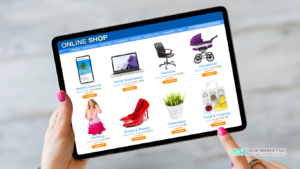The rise of ecommerce has revolutionized how businesses operate and how consumers shop. In the digital age, setting up an online business offers numerous opportunities for entrepreneurs to reach a global audience, reduce operational costs, and create a thriving business from the comfort of their homes.
If you’re new to the concept, this guide will break down everything you need to know about ecommerce, how it works, and what it takes to launch your online business successfully.
1. What Is Ecommerce?
Ecommerce, short for electronic commerce, refers to the buying and selling of goods or services over the internet. It involves various business models, including:
- B2C (Business-to-Consumer): A business sells products directly to consumers, such as an online clothing store.
- B2B (Business-to-Business): Businesses sell products or services to other businesses, like software or wholesale platforms.
- C2C (Consumer-to-Consumer): Consumers sell directly to other consumers, typically through platforms like eBay or Etsy.
- C2B (Consumer-to-Business): Individuals sell products or services to businesses, such as influencers promoting a brand online.
Ecommerce is not limited to physical products. It also encompasses digital products (ebooks, online courses) and services (consulting, marketing services).
2. Why Start an Ecommerce Business?
Starting an ecommerce business comes with a wide array of benefits:
- Low Startup Costs: Unlike traditional brick-and-mortar stores, ecommerce businesses have lower overhead costs. You can avoid expenses such as rent, utilities, and physical store maintenance.
- Global Reach: With an ecommerce platform, your business isn’t limited to one geographical location. You can sell products to customers around the world 24/7.
- Scalability: As your business grows, it’s easier to scale by adding new products, expanding into new markets, or increasing your inventory.
- Flexibility: Running an ecommerce business allows you to work from anywhere and on your own schedule. This flexibility appeals to entrepreneurs seeking a better work-life balance.
3. Choosing the Right Ecommerce Platform
The first step to launching an online business is selecting an ecommerce platform. The right platform will serve as the foundation for your business, offering features to manage products, process payments, and handle shipping.
Here are three popular ecommerce platforms to consider:
- Shopify: Known for its ease of use, Shopify is a leading ecommerce platform offering customizable templates, robust integrations, and secure payment processing. It’s ideal for beginners and small to medium-sized businesses.
- WooCommerce: If you’re familiar with WordPress, WooCommerce is an excellent choice. This plugin turns your WordPress site into a fully functional online store. It’s flexible and highly customizable but may require more technical knowledge.
- BigCommerce: BigCommerce is another popular platform, especially for larger businesses. It offers more built-in features than Shopify and is a great option for businesses looking to scale quickly.
4. Setting Up Your Ecommerce Store
Once you’ve selected an ecommerce platform, it’s time to set up your online store. Here’s a step-by-step guide:
a. Choose a Domain Name
Your domain name is your website’s address (e.g., www.yourstore.com). Choose something simple, memorable, and relevant to your business. If possible, try to secure a “.com” domain as it’s the most widely recognized.
b. Design Your Store
The design of your ecommerce store plays a huge role in user experience and conversion rates. Choose a theme that aligns with your brand and appeals to your target audience. Keep the layout clean, ensure easy navigation, and make sure your site is mobile-friendly.
c. Add Your Products
List the products or services you plan to sell. Include high-quality images, detailed descriptions, pricing, and shipping information. Make sure your product listings are clear and persuasive to encourage potential customers to make a purchase.
d. Set Up Payment Processing
To complete transactions, you’ll need to integrate a payment processor into your ecommerce store. Popular options include PayPal, Stripe, and Shopify Payments. Ensure the checkout process is secure and straightforward to avoid cart abandonment.
e. Test Your Store Before Launch
Before going live, thoroughly test your ecommerce site. Ensure that the website loads quickly, the checkout process works smoothly, and all links are functional. Testing will help you catch any potential issues before your customers do.
5. Driving Traffic to Your Online Store
After setting up your ecommerce store, you need to attract visitors to drive sales. Here are some effective ways to drive traffic:
a. Search Engine Optimization (SEO)
SEO is the process of optimizing your ecommerce website to rank higher in search engine results. It’s a critical strategy for driving organic (non-paid) traffic. Focus on the following SEO elements:
- Keyword Research: Identify and use keywords that your target audience is searching for. Incorporate these keywords into your product descriptions, titles, and blog content.
- On-Page SEO: Optimize your product pages by including keywords in meta tags, alt text for images, and headers. Ensure your website has a clean, fast-loading structure.
- Content Marketing: Write blog posts, guides, or product comparisons to provide valuable information to your audience. This can attract traffic through long-tail keyword searches.
b. Social Media Marketing
Social media platforms like Instagram, Facebook, and Pinterest can drive significant traffic to your ecommerce store. Use high-quality visuals to showcase your products and engage with your audience through comments, stories, and direct messages.
Consider running social media ads to promote new products, special discounts, or seasonal promotions to increase traffic and sales.
c. Email Marketing
Email marketing remains one of the most cost-effective ways to drive traffic and increase conversions. Build an email list by offering promotions, discounts, or valuable content in exchange for a user’s email address.
Segment your email list based on customer behavior (e.g., past purchases, interests) and send personalized campaigns to drive repeat business.
d. Paid Advertising (PPC)
Pay-per-click (PPC) advertising can provide an immediate boost in traffic to your ecommerce store. Google Ads, Facebook Ads, and Instagram Ads allow you to target specific demographics and interest groups. Though PPC requires a budget, it can generate quick results when optimized properly.
6. Managing and Growing Your Ecommerce Business
Once your store is live and traffic is coming in, managing your ecommerce business becomes an ongoing task. Here are a few tips to keep your business thriving:
- Monitor Analytics: Use tools like Google Analytics or the built-in analytics from your ecommerce platform to track website traffic, sales, and customer behavior. This data will help you make informed decisions to improve your marketing strategies and website performance.
- Optimize Conversion Rates: Test different elements of your website, such as product descriptions, images, and checkout processes, to see what works best for converting visitors into buyers.
- Customer Support: Offer prompt and helpful customer support. Provide live chat, email, or phone support to resolve issues quickly and build trust with your audience.
- Focus on Retention: Retaining customers is often more cost-effective than acquiring new ones. Offer loyalty programs, discounts for repeat customers, and personalized product recommendations to keep customers coming back.
Conclusion
Ecommerce is a lucrative and rapidly growing industry. With the right strategy, tools, and execution, you can build a successful online business that reaches a global audience. By following this beginner’s guide, you’ll have the foundational knowledge to start your ecommerce journey, attract traffic, and generate sales.
Remember, success in ecommerce takes time, effort, and continuous optimization. Stay patient and adapt your strategies as your business grows.
About The Author
Jana Legaspi
Jana Legaspi is a seasoned content creator, blogger, and PR specialist with over 5 years of experience in the multimedia field. With a sharp eye for detail and a passion for storytelling, Jana has successfully crafted engaging content across various platforms, from social media to websites and beyond. Her diverse skill set allows her to seamlessly navigate the ever-changing digital landscape, consistently delivering quality content that resonates with audiences.






